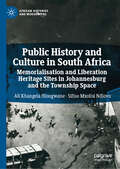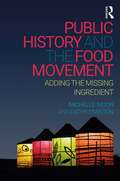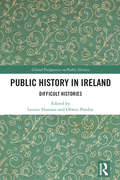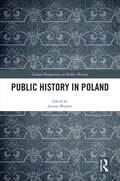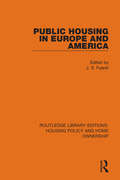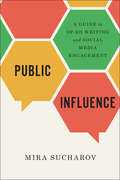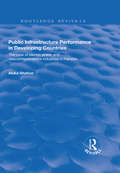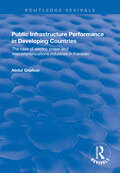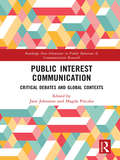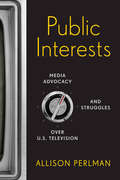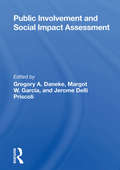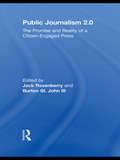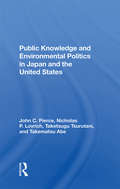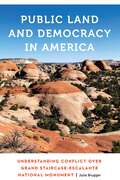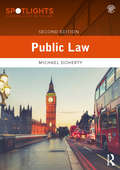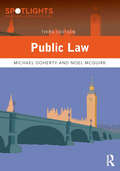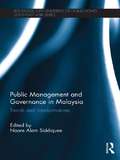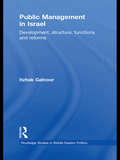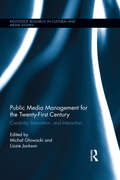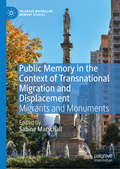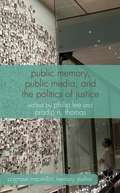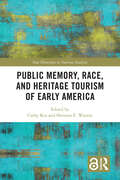- Table View
- List View
Public Health: Disziplin – Praxis – Politik (Sozialwissenschaftliche Gesundheitsforschung)
by Henning Schmidt-Semisch Friedrich SchorbVor drei Jahrzehnten begann sich Public Health an Universitäten und Hochschulen in Deutschland zu etablieren, und die Entwicklung des Faches kann heute allgemein als Erfolgsgeschichte gedeutet werden. Dennoch ist Public Health noch immer kein selbstverständlicher Teil des akademischen Fächerkanons, und auch das Verhältnis zur Politik ist unklar: Einerseits treten Public Health-Akteure dafür ein, dass Gesundheit in allen Politikbereichen berücksichtigt werden soll („Health in all Policies“), andererseits gilt zu viel Politiknähe als Gefahr für die wissenschaftliche Profilbildung.Die Beiträge dieses Bandes fragen in unterschiedlicher Art und Weise nach dem Stand der Disziplin Public Health sowie der entsprechenden Praxis und Politik: Welches Verhältnis hat Public Health zur Praxis von Gesundheitsförderung und Prävention? Kann Public Health heute als eine ‚Profession’ betrachtet werden? Welche disziplinären Zugänge finden sich in Public Health? Wie wirkt Public Health auf Politik ein, und wie beeinflusst – umgekehrt – Politik Public Health? Wie politiknah bzw. wie politisch soll Public Health sein?
Public History and Culture in South Africa: Memorialisation and Liberation Heritage Sites in Johannesburg and the Township Space (African Histories and Modernities)
by Sifiso Mxolisi Ndlovu Ali Khangela HlongwaneThe post-apartheid era in South Africa has, in the space of nearly two decades, experienced a massive memory boom, manifest in a plethora of new memorials and museums and in the renaming of streets, buildings, cities and more across the country. This memorialisation is intricately linked to questions of power, liberation and public history in the making and remaking of the South African nation. Ali Khangela Hlongwane and Sifiso Mxolisi Ndlovu analyse an array of these liberation heritage sites, including the Hector Pieterson Memorial and Museum, the June 16, 1976 Interpretation Centre, the Apartheid Museum and the Mandela House Museum, foregrounding the work of migrant workers, architects, visual artists and activists in the practice of memorialisation. As they argue, memorialisation has been integral to the process of state and nation formation from the pre-colonial era through the present day.
Public History and the Food Movement: Adding the Missing Ingredient
by Cathy Stanton Michelle MoonPublic History and the Food Movement argues that today’s broad interest in making food systems fairer, healthier, and more sustainable offers a compelling opportunity for the public history field. Moon and Stanton show how linking heritage institutions’ unique skills and resources with contemporary food issues can offer accessible points of entry for the public into broad questions about human and environmental resilience. They argue that this approach can also benefit institutions themselves, by offering potential new audiences, partners, and sources of support at a time when many are struggling to remain relevant and viable. Interviews with innovative practitioners in both the food and history fields offer additional insights. Drawing on both scholarship and practice, Public History and the Food Movement presents a practical toolkit for engagement. Demonstrating how public historians can take on a vital contemporary issue while remaining true to the guiding principles of historical research and interpretation, the book challenges public historians to claim an expanded role in today’s food politics. The fresh thinking will also be of interest to public historians looking to engage with other timely issues.
Public History in Ireland: Difficult Histories (Global Perspectives on Public History)
by Leonie Hannan Olwen PurdueThrough a collection of essays that reflect the complexity of the island’s historical past as it operates today, Public History in Ireland delivers a scholarly yet accessible introduction to contemporary topics and debates in Irish public history.Despite the reputation that Ireland, both north and south, has gained as a place of contestation, this is the first book-length study to tackle its diverse and often ‘difficult’ public histories. Public History in Ireland offers examples drawn not only from museums, heritage and collections, prime mediators of public historical interpretation, but also from the work of artists and academics. It considers the silences in Ireland’s history-telling, including those of the recent conflict in Northern Ireland and of the traumatic public discoveries and re-evaluations of the island’s institutions of social control. The book’s key message is that history is active, making itself felt in ongoing debates about heritage, identity, nationhood, post-conflict society and reparative justice. It shows that Irish public history is freighted and often fraught with jeopardy, but as such it is rich with insight that has relevance far beyond this island’s shores.This book is useful for students, scholars and practitioners working in the fields of public history and the history of Ireland.
Public History in Poland (Global Perspectives on Public History)
by Joanna WojdonThis volume presents various aspects of public history practices in Poland, alongside their historical development and theoretical reflections on public history. Despite a long tradition and variety of forms of public history, the very term "public history", or literally speaking "history in the public sphere", has been in use in Poland only since the 2010s. This edited collection contains chapters that focus on numerous practices and media forms in public history including historical memory, heritage tourism, historical re-enactments, memes and graphic novels, films, archives, archaeology and oral history. As such, the volume brings together the Polish experiences to wider international audiences and shares Polish controversies related to public history within the academic discourse, beyond media news and politically engaged commentaries. Furthermore, it sheds crucial light on the developments of collective memory, historical and political debates, the history of Poland and East-Central Europe, and the politics of post-World War Two and post-communist societies. Authored by a team of academic historians and practitioners from the field, Public History in Poland is the perfect resource for students from a variety of disciplines including Public History, Heritage, Museum Studies, Anthropology, and Archaeology.
Public Housing in Europe and America
by J. S. FuerstOriginally published in 1974, this book surveys the experience of public and quasi public housing in the UK, USA, France, Germany, the former USSR, Israel, Denmark, Sweden, Hungary and Puerto Rico. Each country’s housing policy is set in a broad social and historical context, showing how the policy developed and how effective it was. Administrative problems encountered in different countries are evaluated and compared and many similarities emerge. The relationship of housing to transport, education and employment is discussed and special attention is focused on the role of new towns in Sweden, the former USSR, the UK, Israel and the USA.
Public Influence: A Guide to Op-Ed Writing and Social Media Engagement
by Mira SucharovHow can twenty-first-century scholars and other experts craft their voices for audiences beyond their peers? In Public Influence, political scientist Mira Sucharov walks readers through the ins and outs of op-ed writing and social media engagement. Presented in a lively and engaging style, Public Influence coaches readers on the best approach to pitching and writing op-eds and other related analytical pieces, managing the ensuing conversation, conveying informed ideas to an evidence-resistant audience, avoiding social media hazards in an increasingly polarized environment, harnessing outrage culture to organize sensitively and intelligently, and using political labels in ways that cut through the noise. Enlivened with discussions of an array of hot-button issues and examples of public influence succeeding wildly and going terribly awry, Public Influence is essential reading for anyone who wants to harness the opportunities of public engagement in a dynamic digital age.
Public Infrastructure Performance in Developing Countries (Routledge Revivals)
by Abdul GhafoorThis title was first published in 2000: An investigation of the performance of the electric power and telecommunication sectors of Pakistan at the firm level as well as the sector as a whole, seeking to identify and quantify the extent of inefficiencies. Since physical or financial or productivity indicators alone are not able to explain the duality of public infrastructure purposes, the financial and productivity indicators have been used in evaluating the performance of these sectors. Further, a Cobb-Douglas production function has also been used to calculate the trend in the growth of total factor productivity. Economies of scale have also been studied in the case of electric power generation. The results of the study show that in Pakistan one of the usual motives for privatization (to avoid the poor financial results of state enterprises) is not relevant for electricity and telecommunications enterprises. This, however, appears to be due to the financial subsidies they received, through access to low cost loan finance and grants, rather than to their efficiency in operations. By the economic criteria of growth of TFP none of the enterprises do well and two have a negative TFP growth. The case for reforming these enterprises is strong and alternative modes of organization, finance and ownership need to be considered.
Public Infrastructure Performance in Developing Countries (Routledge Revivals)
by Abdul GhafoorThis title was first published in 2000: An investigation of the performance of the electric power and telecommunication sectors of Pakistan at the firm level as well as the sector as a whole, seeking to identify and quantify the extent of inefficiencies. Since physical or financial or productivity indicators alone are not able to explain the duality of public infrastructure purposes, the financial and productivity indicators have been used in evaluating the performance of these sectors. Further, a Cobb-Douglas production function has also been used to calculate the trend in the growth of total factor productivity. Economies of scale have also been studied in the case of electric power generation. The results of the study show that in Pakistan one of the usual motives for privatization (to avoid the poor financial results of state enterprises) is not relevant for electricity and telecommunications enterprises. This, however, appears to be due to the financial subsidies they received, through access to low cost loan finance and grants, rather than to their efficiency in operations. By the economic criteria of growth of TFP none of the enterprises do well and two have a negative TFP growth. The case for reforming these enterprises is strong and alternative modes of organization, finance and ownership need to be considered.
Public Interest Communication: Critical Debates and Global Contexts (Routledge New Directions In Public Relations And Communication Research Ser.)
by Jane Johnston Magda PieczkaCommunication has become the technology of public interest, demanding a re-examination of the key concept of public in both public relations and communication theory. This book defines a new concept of public interest communication, combining the conflict, negotiation and adaptation inherent in public interest, with a critical approach to communication management and public relations. Combining conceptual discussions about public theories of language with the tension between the public and private interests for public relations professionals, the book uses case studies to explore the negotiation of conflicting interests and the construction of the public interest within systems of governance at local, national and international levels. Public interest communication is identified within social and cultural contexts that resonate globally – health, community, media and the environment - each representing interest conflicts within the changing global environment. Addressing the forces of fragmentation, inequality and individualisation that characterize the modern world, this thought-provoking volume will be of great interest to researchers and advanced students of communication, public relations, environmental communication, public communication, and public policy.
Public Interests: Media Advocacy and Struggles over U.S. Television
by Allison PerlmanNearly as soon as television began to enter American homes in the late 1940s, social activists recognized that it was a powerful tool for shaping the nation's views. By targeting broadcast regulations and laws, both liberal and conservative activist groups have sought to influence what America sees on the small screen. Public Interests describes the impressive battles that these media activists fought and charts how they tried to change the face of American television. Allison Perlman looks behind the scenes to track the strategies employed by several key groups of media reformers, from civil rights organizations like the NAACP to conservative groups like the Parents Television Council. While some of these campaigns were designed to improve the representation of certain marginalized groups in television programming, as Perlman reveals, they all strove for more systemic reforms, from early efforts to create educational channels to more recent attempts to preserve a space for Spanish-language broadcasting. Public Interests fills in a key piece of the history of American social reform movements, revealing pressure groups' deep investments in influencing both television programming and broadcasting policy. Vividly illustrating the resilience, flexibility, and diversity of media activist campaigns from the 1950s onward, the book offers valuable lessons that can be applied to current battles over the airwaves.
Public Involvement And Social Impact Assessment
by Gregory Daneke Jerome Delli Priscoli Margot GarciaThe participation of the public sector in assessing the socialimpact of a wide range of projects is the focus of this ground-breakingbook. Leading experts from the u.s. and canada have contributedoriginal articles based on their empirical research conducted in currentimpact situations. These are supplemented by the editors' analyticaloverviews. The book concludes with projections regardingfuture linkages between public involvement and social impact assessment.Dr. Gregory A. Daneke is associate professor of public affairsand business administration at Arizona State University. He has coeditedEnergy Policy and Public Administration (1980) and coauthoredPerformance Administration: Improved Responsiveness and Effectivenessin Public services (1980). Dr. Margot w. Garcia is a program analystwith the USDA Forest Service; as part of a .nationwide training programfor the Forest Service in land management planning, she taught publicinvolvement and land management planning. Dr. Jerome Delli Priscoliis senior policy analyst at the Institute for Water Resources, u.s.Army Corps of Engineers, Ft. Belvoir, Virginia.
Public Journalism 2.0: The Promise and Reality of a Citizen Engaged Press
by Jack Rosenberry Burton St JohnWhere does journalism fit in the media landscape of blogs, tweets, Facebook postings, YouTube videos, and literally billions of Web pages? Public Journalism 2.0 examines the ways that civic or public journalism is evolving, especially as audience-created content—sometimes referred to as citizen journalism or participatory journalism—becomes increasingly prominent in contemporary media. As the contributors to this edited volume demonstrate, the mere use of digital technologies is not the fundamental challenge of a new citizen-engaged journalism; rather, a depper understanding of how civic/public journalism can inform citizen-propelled initiatives is required. Through a mix of original research, essays, interviews, and case studies, this collection establishes how public journalism principles and practices offer journalists, scholars, and citizens insights into how digital technology and other contemporary practices can increase civic engagement and improve public life. Each chapter concludes with pedagogical features including: * Theoretical Implications highlighting the main theoretical lessons from each chapter, * Practical Implications applying the chapter's theoretical findings to the practice of citizen-engaged jouranlis, *Reflection Questions prompting the reader to consider how to extend the theory and application of the chapter. blogging and other participatory journalism practices enabled by digital technology are not always in line with the original vision of public journalism, which strives to report news in such a way as to promote civic engagement by its audience. Public Journalism 2.0 seeks to reinvent public journalism for the 21st century and to offer visions of how digital technology can be enlisted to promote civic involvement in the news.
Public Justice and the Anthropology of Law
by Ronald Niezen"In this powerful, timely study Ronald Niezen examines the processes by which cultural concepts are conceived and collective rights are defended in international law. Niezen argues that cultivating support on behalf of those experiencing human rights violations often calls for strategic representations of injustice and suffering to distant audiences. The positive impulse behind public responses to political abuse can be found in the satisfaction of justice done. But the fact that oppressed peoples and their supporters from around the world are competing for public attention is actually a profound source of global difference, stemming from differential capacities to appeal to a remote, unknown public. Niezen's discussion of the impact of public opinion on law provides fresh insights into the importance of legally-constructed identity and the changing pathways through which it is being shaped - crucial issues for all those with an interest in anthropology, politics and human rights law"--
Public Knowledge And Environmental Politics In Japan And The United States
by John C Pierce Nicholas P Lovrich Taketsugu Tsurutani Takematsu AbeThis book grows out of the authors' conviction that as public policy issues become suffused with scientific and technical content, they become difficult for the democratic citizens to understand. It attempts to determine mass public capacity and their motivation to respond to the challenges.
Public Land and Democracy in America: Understanding Conflict over Grand Staircase-Escalante National Monument (Anthropology of Contemporary North America)
by Julie BruggerIn recent years the Grand Staircase-Escalante National Monument in southern Utah has figured prominently in the long and ongoing struggle over the meaning and value of America&’s public lands. In 1996 President Bill Clinton used the Antiquities Act to create the monument, with the goal of protecting scientific and historical resources. His action incensed Utah elected officials and local residents who were neither informed nor consulted beforehand, and opposition to the monument has continued to make its day-to-day management problematic. In 2017 President Donald Trump reduced the monument&’s size, an action immediately challenged by multiple lawsuits; subsequently, President Joe Biden restored the monument in 2021. In Public Land and Democracy in America Julie Brugger brings into focus the perspectives of a variety of groups affected by conflict over the monument, including residents of adjacent communities, ranchers, federal land management agency employees, and environmentalists. In the process of following management disputes at the monument over the years, Brugger considers how conceptions of democracy have shaped and been shaped by the regional landscape and by these disputes. Through this ethnographic evidence, Brugger proposes a concept of democracy that encompasses disparate meanings and experiences, embraces conflict, and suggests a crucial role for public lands in transforming antagonism into agonism.
Public Law (Spotlights)
by Michael DohertyPublic Law is an ideal choice for all undergraduate and GDL students looking for a comprehensive yet accessible textbook on this area of law. The author’s clear writing style, accessible tone, and focus on modern case law help bring the subject to life. The book covers the key institutions, concepts, and legal rules of the United Kingdom’s constitutional system, with the chapters arranged around four subjects: the foundations of the constitutional system; Constitutional Law; Administrative Law; and human rights. The book’s central theme is that of state power, and the relationship between the state and the citizen. The second edition has been revised to reflect recent key developments in Public Law, and now extensively explores, in addition to several other key chapter updates, the impact of the 2016 EU referendum, the 2017 General Election, and changes in devolution across England, Scotland, and Wales. Clearly written and easy to use, Public Law enables students to fully engage with the topic and gain a profound understanding of this fundamental, exciting area. The Routledge Spotlights series brings a modern, contemporary approach to the core curriculum for the LLB and GDL, which will help students: to move beyond an understanding of the law to refine and develop the key skills of problem-solving, evaluation and critical reasoning, which are essential to assessment success to discover sources and suggestions for taking your study further By focusing on recent case law and real-world examples, Routledge Spotlights will help you shed light on the law, understand how it operates in practice and gain a unique appreciation of the contemporary context of the subject. This book is supported by a range of online resources developed to support your learning, keep you up-to-date and to help you prepare for assessments.
Public Law (Spotlights)
by Michael Doherty Noel McGuirkPublic Law is an ideal choice for all students looking for a comprehensive yet accessible textbook on this area of law, as its clear writing style, accessible tone, and focus on modern case law help bring the subject to life. The book covers the key institutions, concepts, and legal rules of the United Kingdom’s constitutional system, with the chapters arranged around four subjects: the foundations of the constitutional system; Constitutional Law; Administrative Law; and human rights. The book’s central theme is that of state power, and the relationship between the state and the citizen. Co-authored by Michael Doherty and Noel McGuirk, the third edition has been revised to reflect recent key developments in Public Law. It now extensively explores, in addition to several other key chapter updates, the unfolding impact of Brexit, the 2019 General Election, changes in devolution across England, Scotland, and Wales, and the 2020 Coronavirus Act. Clearly written and easy to use, Public Law enables students to fully engage with the topic and gain a profound understanding of this fundamental, exciting area. The Routledge Spotlights series brings a modern, contemporary approach to the core law curriculum, which will help students: - To move beyond an understanding of the law. - To refine and develop the key skills of problem-solving, evaluation and critical reasoning, which are essential to assessment success. - To discover sources and suggestions for taking your study further. By focusing on recent case law and real-world examples, Routledge Spotlights will help you shed light on the law, understand how it operates in practice, and gain a unique appreciation of the contemporary context of the subject.
Public Management and Governance in Malaysia: Trends and Transformations (Routledge/City University of Hong Kong Southeast Asia Series)
by Noore Alam SiddiqueeThe past two and a half decades have seen major transformations in public sector management and governance across the globe. This book examines the ways public sector management and governance in Malaysia has changed and is changing under contemporary reform models. Chapters are written by well-established scholars and academics with intimate knowledge in their respective fields, and provide a thorough and insightful analysis of the reform trends and developments on a range of topics. These include performance management, compensation reforms, public budgeting, accounting and reporting, privatisation and public-private partnership, e-government, managing ethics and accountability, local government and inter-governmental relations. While the book surveys the topics that are central to public sector management and governance, it also focuses on the nature of reforms and changes that were introduced, as well as the forces that have shaped their design and implementation process, and the initial impacts and results. Overall, the book provides students and scholars of Politics and Southeast Asian Studies with a greater appreciation and deeper understanding of the recent developments and current trends of public sector management.
Public Management in Israel: Development, Structure, Functions and Reforms (Routledge Studies in Middle Eastern Politics)
by Itzhak GalnoorAs government management in Israel is gradually replaced by private sector management, it is becoming apparent that the collective-oriented mission of government cannot be fulfilled by the private sector or by the non-profit organizations of civil society. This book provides an analysis of the machinery of government in Israel, highlighting the inadequacy of the private sector as an alternative and how public management will need to cope with the new challenges and pressures of the 21st century. Providing hitherto unpublished data and analysis in English for the first time, this book gives a comprehensive analysis of the issue of public and private-sector management. The author examines the tasks of the civil service; the legal foundation of the public management machinery; and the profile of civil servants, and looks at the unwieldy budget process; the prevalence (and absence) of regulation; and external and internal mechanisms of oversight. This analysis is balanced by a detailed exposition of Israel's political-administrative culture with its excessive centralization, secrecy, turf protection, and legacy of improvisation, and their effect on policymaking and administration. This comprehensive and detailed examination of public management in Israel will be of great interest both to students and scholars of business and management, government and politics, and to policymakers in the region.
Public Media Management for the Twenty-First Century: Creativity, Innovation, and Interaction (Routledge Research in Cultural and Media Studies)
by Michał Głowacki Lizzie JacksonThis book analyzes the challenges facing public service media management in the face of ongoing technological developments and changing audience behaviors. It connects models, strategies, concepts, and managerial theories with emerging approaches to public media practices through an examination of media services (e.g. blogs, social networks, search engines, content aggregators) and the online performance of traditional public media organizations. Contributors identify the most relevant and useful approaches, those likely to encourage creativity, interaction, and the development of innovative content and services, and discuss how such innovation can underpin the continuation or expansion of public service media in the changing mediascape.
Public Memory in the Context of Transnational Migration and Displacement: Migrants and Monuments (Palgrave Macmillan Memory Studies)
by Sabine MarschallThis book explores the border-transcending dimensions of public remembering by focussing on the triangular relationship between memory, monuments and migration. Framed by an introduction and conclusion, nine case studies located in diverse social and geo-political settings feature topical debates and contestation around monuments, statues and memorials erected by migrants or in memory of migrants, refugees and diasporas in host country societies. Written from different disciplinary perspectives including anthropology, art history, cultural studies and political science, the chapters consider displaced people as new, originally unintended audiences who bring transnational and transcultural perspectives to old monuments in host cities. In addition, migrants and diasporic communities are explored as ‘agents of memory’, who produce collective memory in tense environments of intra- and inter-group negotiation or outright hostility at the national and transnational level. The research is conceptually anchored in memory studies, notably transnational memory, multidirectional memory and other concepts emerging from memory studies’ recent ‘transcultural turn’.
Public Memory, Public Media, and the Politics of Justice
by Pradip Ninan Thomas Philip LeeExposing how memory is constructed and mediated in different societies, this collection explores particular contexts to identify links between the politics of memory, media representations and the politics of justice, questioning what we think we know and understand about recent history.
Public Memory, Race, and Heritage Tourism of Early America (New Directions in Tourism Analysis)
by Cathy Rex and Shevaun E. WatsonThis book addresses the interconnected issues of public memory, race, and heritage tourism, exploring the ways in which historical tourism shapes collective understandings of America’s earliest engagements with race. It includes contributions from a diverse group of humanities scholars, including early Americanists, and scholars from communication, English, museum studies, historic preservation, art and architecture, Native American studies, and history. Through eight chapters, the collection offers varied perspectives and original analyses of memory-making and re-making through travel to early American sites, bringing needed attention to the considerable role that tourism plays in producing—and possibly unsettling—racialized memories about America’s past. The book is an interdisciplinary effort that analyses lesser-known sites of historical and racial significance throughout North America and the Caribbean (up to about 1830) to unpack the relationship between leisure travel, processes of collective remembering or forgetting, and the connections of tourist sites to colonialism, slavery, genocide, and oppression. Public Memory, Race, and Heritage Tourism of Early America provides a deconstruction of the touristic experience with racism, slavery, and the Indigenous experience in America that will appeal to students and academics in the social sciences and humanities.
Public Memory, Race, and Heritage Tourism of Early America (New Directions in Tourism Analysis)
by Cathy Rex and Shevaun E. WatsonThis book addresses the interconnected issues of public memory, race, and heritage tourism, exploring the ways in which historical tourism shapes collective understandings of America’s earliest engagements with race.It includes contributions from a diverse group of humanities scholars, including early Americanists, and scholars from communication, English, museum studies, historic preservation, art and architecture, Native American studies, and history. Through eight chapters, the collection offers varied perspectives and original analyses of memory-making and re-making through travel to early American sites, bringing needed attention to the considerable role that tourism plays in producing—and possibly unsettling—racialized memories about America’s past. The book is an interdisciplinary effort that analyses lesser-known sites of historical and racial significance throughout North America and the Caribbean (up to about 1830) to unpack the relationship between leisure travel, processes of collective remembering or forgetting, and the connections of tourist sites to colonialism, slavery, genocide, and oppression.Public Memory, Race, and Heritage Tourism of Early America provides a deconstruction of the touristic experience with racism, slavery, and the Indigenous experience in America that will appeal to students and academics in the social sciences and humanities.

